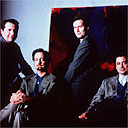
"Theatre without words," is how the programme for the Emerson Quartet's Shostakovich retrospective describes the composer's string quartets. The phrase might surprise some, though it points to the reasons for Shostakovich's initial attraction to the form, as well as to the essence of the Emersons' approach.
The quartets are widely regarded as constituting Shostakovich's private reflections, as opposed to the public statements of the symphonies. The First dates from 1938, shortly after the premiere of the Fifth Symphony brought about his rehabilitation in the eyes of the Soviet authorities. Yet the crisis that produced the symphony also led to Shostakovich's decision to abandon his career as an opera composer. His early quartets, however, contain elements of operatic form, notably in the almost vocal thematic material of the First and the use of movement titles like Overture, Recitative and Romance in the Second. We are consequently being asked to re-examine the quartets as music drama, dependent on the theatrical interaction of individual voices.
This sense of drama was very much to the fore in the Emersons' opening concert, which refuted the sometimes-voiced criticism that their playing aspires solely to cool perfectionism. The violin arias of the First, expansively articulated by Eugene Drucker, were undercut at every turn by intimations of turmoil. The clash between the instrumentalists deepened in the Second Quartet, in which Drucker's playing, urgent and at times imperious, alternately seemed to goad and coax the other players into life.
The two violinists exchanged roles for the Third Quartet, which was led by Phillip Setzer. This is the first of the series in which the lower instruments begin to assume a prominent individual character, with the viola repeatedly pulling the first violin's acrobatics off balance then instigating dictatorial violence. The performance was hair-raising and, at the end, after the music's final collapse into utter exhaustion, there was a long silence before the applause erupted.

